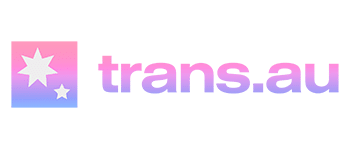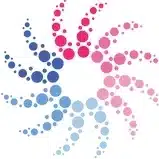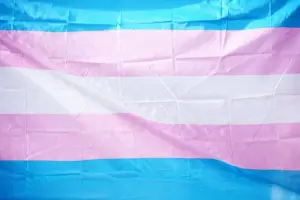This article was originally published by the Trans Health Research team. You can find the original article here.
Authors: Dr Sav Zwickl, Tomi Ruggles, and Joël Murray
Content Warning: Brief mention of healthcare discrimination, gender-affirming surgeries using medical terms for body parts, and mental health. There is also a photograph of a non-binary person holding a syringe, about to inject testosterone.
Note: It is generally recommended that non-binary people are not divided up according to their sex recorded at birth, as this can shift the focus from gender towards sex in a way that can undermine non-binary identities and experiences. However, in some cases, this categorisation is important, including where there are notable differences based on sex recorded at birth that warrant acknowledgement and discussion.

A non-binary person hugging their agender non-binary partner. Image credit: Levi Meir Clancy.
Non-binary is a broad umbrella term for people who have a gender that does not fit exclusively into the woman/man gender binary. This includes a broad range of genders, including genderqueer, genderfluid, bigender, and agender.
Somewhere between a quarter and half of the Australian trans and gender-diverse community are non-binary.
There is a common perception that non-binary people rarely want gender-affirming hormone therapy (GAHT) and gender-affirming surgery (GAS). When these perceptions are held by doctors, it can make it difficult for non-binary people to access the healthcare they need.
Using data collected from our TRANSform study, we set out to dispel this myth and explore how many non-binary people in Australia have had or want GAHT and GAS. Our findings were recently published in the International Journal of Transgender Health.

A non-binary person about to inject testosterone. Image credit: Gender Spectrum Collection.
How common is gender-affirming hormone therapy in non-binary people?
In our survey of 271 non-binary people, two-thirds (66%) of survey respondents reported they had ever used or wanted to use GAHT.
In non-binary people presumed female at birth (PFAB), nearly half (49%) reported that they were using testosterone GAHT, 9% had previously but were not currently using testosterone, and 6% wanted to start testosterone.
In non-binary people presumed male at birth (PMAB), 59% reported that they were currently using GAHT, 7.5% had previously but were not currently using GAHT, and 11% wanted to start GAHT. Oestrogen was the most common type of GAHT (57%), followed by anti-androgens (38%), and progesterone (15%).
We also compared our results to the two other Australian surveys that have asked non-binary people about GAHT. Both the Hyde et al survey (2013) and the Hill et al survey (2020), indicated about half of non-binary people had used or wanted GAHT. Our 66% suggests that the number of non-binary people using and wanting GAHT has increased over the last decade.
How common is gender-affirming surgery in non-binary people?
Across the entire group of non-binary people we surveyed, just under half (49%) had or wanted GAS.
In non-binary people PFAB, 28% reported having top surgery (surgery to create a flat chest), 3% had a hysterectomy (removal of the uterus and sometimes the cervix) and 2% had an oophorectomy (removal of one or both ovaries). An additional 23% of non-binary people PFAB wanted but had not had any type of GAS.
In non-binary people PMAB, 4% had an orchiectomy (removal of the testicles), 2% had vaginoplasty (creation of a vagina), and 2% had zero-depth labioplasty (creation of vulva but no vagina). An additional 26% of non-binary people PMAB wanted but had not had any type of GAS.

A trans person who has had top surgery without nipple reconstruction. Image credit: Freepik.
What are some of the different approaches non-binary people have to hormones and surgery?
Non-binary people (and all trans and gender-diverse people) can take different approaches to GAHT and GAS. Our research showed that 44% of non-binary people want both GAHT and GAS, 8% don’t want any form of GAHT or GAS, and the rest fall somewhere in-between, including wanting GAHT but not GAS, and wanting GAS but not GAHT. Many non-binary people were still thinking about what is right for them.
While some non-binary people access GAHT doses that are typically associated with trans men or trans women (i.e. ‘full doses’), others use GAHT for shorter periods of time or lower doses of GAHT to achieve their gender affirmation goals. Some non-binary people PMAB who do not want the breast growth that comes with oestrogen, may use selective estrogen receptor modulators (or SERMs) however, it is not clear what the benefits or harms are.
There are also different approaches to GAS. For example, while some non-binary people PFAB want a ‘typically masculine chest’, others may seek different surgical outcomes, such as different nipple placement, complete removal of the nipples, or a non-flat chest. In non-binary people PMAB, different GAS options include creation of labia without the construction of a vagina (depthless/zero-depth labiaplasty), removal of testicles without construction of a vagina, and construction of a vagina while keeping the penis.

A non-binary person speaking during a video telehealth appointment. Image credit: Renata Angerami.
What barriers do non-binary people face to accessing hormones and surgery?
For a very long time, non-binary people (and others who did not conform to binary gender norms), faced significant barriers to accessing GAHT and GAS, and some were denied the care they needed by doctors. As a result, some non-binary people have presented to doctors as trans men or trans women to access what they need, and some have accepted ‘typical’ GAHT doses and GAS because doctors would not allow for alternate approaches.
The good news is that access to GAHT in Australia has improved significantly in recent years. Prescription of GAHT has moved away from older guidelines that involved mental health assessments and requirements to conform to binary ideas of gender, to an Informed Consent Model of Care, which positions the trans person as the expert on their own gender.
This shift to Informed Consent has played a big role in reducing the number of non-binary people who want but have not yet started GAHT. In our survey, we found that of those people who had ever used or wanted GAHT (total need), 10% reported they were wanting to start GAHT (unmet need). This is much lower than the rates of unmet need reported by Hyde et al survey (2013) (56% of total need) and Hill et al survey (2020), (47% of total need).
In terms of GAS, our research indicates that top surgery is being accessed by non-binary people PFAB at four times the rate it was in 2013 (28% in our survey compared to 6.6% in Hyde et al survey (2013). This may be related to the increasing number of surgeons who are willing to provide GAS to people who are not using GAHT and ‘non-typical’ surgical outcomes, such as removal of the nipples.
Generally, however, unmet need for GAS remains very high. In non-binary people PFAB who reported they had had or wanted GAS, almost half (43%) had not been able to access GAS, and no one we surveyed had accessed metoidioplasty or phalloplasty (surgeries to create a penis). In non-binary people PMAB, the rate of unmet need for GAS was even higher – of those who had had or wanted GAS, 82% had not yet accessed any type of GAS.
These high rates of unmet need for GAS are likely related to historical surgery readiness assessments based on strict binary notions of gender. Financial inaccessibility of GAS in Australia is also a major issue, with GAS requiring large out-of-pocket costs, ranging between $10,000 for chest surgery to over $100,000 for some types of phalloplasty. In promising news, however, there has been a submission to the Medical Services Advisory Committee. If this submission is successful, it will create greater clarity for health care practitioners and individuals by creating GAS-specific reimbursement codes for the Medicare Benefits Scheme. We are hoping this leads to greater access to GAS.

A patient being supported by a practitioner. Image credit: RDNE Stock Project.
Better education and training needed
Our recent survey of the Australian non-binary community shows that contrary to the myth that non-binary people rarely or never want GAHT and GAS, it is in fact very common.
Like trans men and trans women, non-binary people can ,benefit immensely from access to GAHT and GAS, including improvements in quality of life and mental health, and reductions in gender dysphoria and suicidality.
It is, therefore, important that non-binary people have better access to information about different options for gender affirmation so that they can make informed decisions. Likewise, healthcare professionals need better education about the diversity of medical affirmation pathways, so that they can provide good quality, patient-centered care.
Authors:
Dr Sav Zwickl (they/them) is a trans non-binary Research Fellow with the Trans Health Research group, where they lead TRANSform, Australia’s largest longitudinal trans health study. They have a Masters degree in Sexology, a PhD in Gender, Sexuality and Diversity Studies, and experience in LGBTIQA+ peer support.
Tomi Ruggles (she/her) is a Registered Nurse and proud queer Australian, with an MA in Social Work. Tomi is passionate about supporting the trans community and wishes to address social inequity through advocacy and research. Tomi has worked with marginalised populations, elderly Australians, and Australians who live with a disability for over a decade.
Joël Murray (they/them) is a non-binary queer person who has been living with HIV since 2010. They have worked in program management, policy, evaluation, research, and advocacy roles for HIV and LGBTQ+ organisations. Joël has a Master of Public Health in Health Economic Evaluation from the University of NSW. Currently, they are Principal Consultant at Neophile, with a focus on technical advisory for key populations in the global HIV response.





